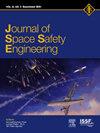A critical analysis of reentry debris uncertainty and international coordination efforts
IF 1.7
Q3 ENGINEERING, AEROSPACE
引用次数: 0
Abstract
The recent rapid advancement of commercial space operations has highlighted high levels of reentry debris modeling uncertainty and the lack of efficient international coordination for exchanging information to ensure these operations are conducted safely. One such source of modeling uncertainty occurs in aerothermal demise predictions of debris fragments while performing flight safety analysis for controlled reentries. Using current models, predicting aerothermal demise for any type of reentry with a high degree of certainty is a time and resource intensive process due to a lack of data, the introduction of new materials, and the complexity of current models. Another layer of uncertainty is introduced for cases of uncontrolled or random reentry of an object. For random reentry cases, there is limited capability to predict when and where debris will impact Earth’s surface.
Advancements in understanding of the risks from space operations, including controlled reentries, debris from launch, and random reentries, will allow countries to have higher certainty when a particular area may be exposed to risk. Existing international frameworks and processes are not agile enough to enable efficient data sharing, communication, or real time operational coordination for mitigating hazards from these space operations. Given the differences in jurisdiction, issues of sovereignty, lack of standardized procedures, and the ambiguity in implementing international space laws and treaties, the high degree of uncertainty in the risk predictions poses additional challenges with respect to the implementation of safety measures such as warnings and closures.
This paper investigates how improvements will be needed to safeguard public safety for reentry operations across the globe, by highlighting shortcomings in modeling ability and opportunities for increased operational coordination and communication with international partners.
对再入大气层碎片不确定性和国际协调努力的批判性分析
最近商业空间业务的迅速发展凸显了再入大气层碎片建模的高度不确定性,以及在交换信息以确保这些业务安全进行方面缺乏有效的国际协调。在对受控再入进行飞行安全分析时,碎片碎片的气动热消亡预测就是这样一个建模不确定性的来源。使用现有模型,由于缺乏数据、新材料的引入以及现有模型的复杂性,预测任何类型再入的气动热消亡都是一个时间和资源密集型的过程。另一层不确定性是针对不受控制或随机重新进入的对象引入的。对于随机再入情况,预测碎片何时何地撞击地球表面的能力有限。对空间行动风险的进一步了解,包括控制再入、发射碎片和随机再入,将使各国在某一特定区域可能面临风险时具有更高的确定性。现有的国际框架和进程不够灵活,无法实现有效的数据共享、通信或实时业务协调,以减轻这些空间业务的危害。鉴于管辖权的差异、主权问题、缺乏标准化程序以及在执行国际空间法律和条约方面的模糊性,风险预测的高度不确定性给执行警告和关闭等安全措施带来了额外的挑战。本文通过强调建模能力的不足以及与国际合作伙伴加强业务协调和沟通的机会,研究了如何改进以保障全球再入行动的公共安全。
本文章由计算机程序翻译,如有差异,请以英文原文为准。
求助全文
约1分钟内获得全文
求助全文
来源期刊

Journal of Space Safety Engineering
Engineering-Safety, Risk, Reliability and Quality
CiteScore
2.50
自引率
0.00%
发文量
80
 求助内容:
求助内容: 应助结果提醒方式:
应助结果提醒方式:


